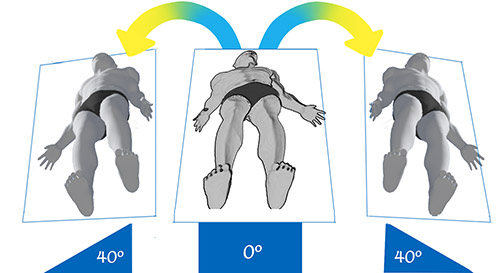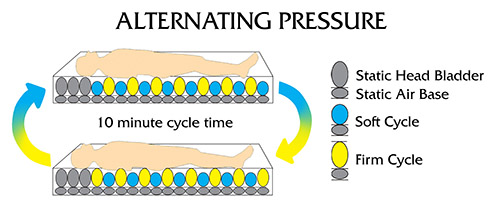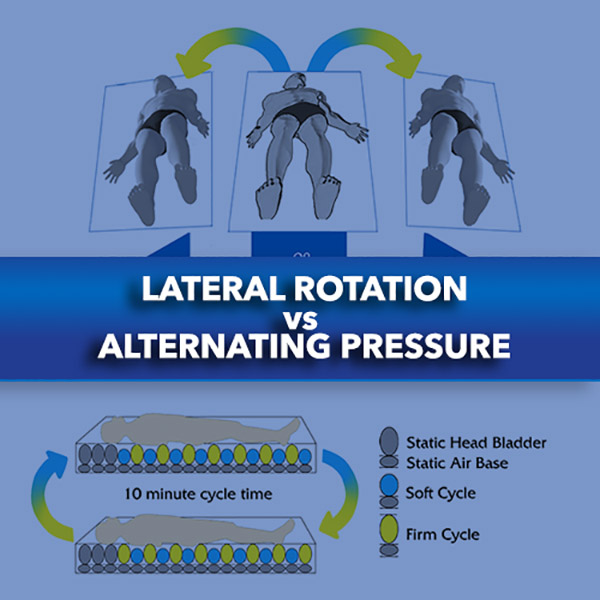Lateral Rotation Mattress vs Alternating Pressure Mattress. Which is the right choice to prevent and treat bedsores?
A Lateral Rotation Mattress, AKA a turning mattress, "turns" or "rotates" the patient side to side to redistribute pressure. This movement simulates how nursing staff repositions or turns a patient to help prevent pressure ulcers. We receive calls from caregivers requesting a Lateral Rotation Mattress System. When asked if a medical professional suggested lateral rotation therapy for the prevention or treatment of a pressure ulcer, the answer is most often "NO, I found it online". Others say, "nurses turn people side to side every two hours, and I think that is what I need". This sounds logical however, it is not always accurate.
Lateral Rotation Mattress vs Alternating Pressure Mattress
Caregivers assume that a lateral rotation mattress replicates manual turning in the hospital. This is the reason many ask for this type of system. However, while a lateral rotation mattress does help prevent and treat stages I-IV pressure ulcers, it is utilized when specific conditions exist. One of the most important considerations is the presence of significant respiratory issues. If the conditions outlined below do not exist, an Alternating Pressure Mattress with Low Air Loss may be more appropriate. Additionally, Alternating Pressure Mattress Systems cost considerably less than lateral rotation.


Lateral Rotation therapy rotates the patient to achieve pressure redistribution.
Alternating Pressure therapy, the mattress bladders alternate underneath the patient.
The difference between Lateral Rotation and Alternating Pressure.
Both systems relieve pressure for the prevention and treatment of pressure injuries. However, how they relieve the pressure for skin protection and when each is used is entirely different.
LATERAL ROTATION
A lateral rotation low air loss mattress system uses air to move the patient side-to-side in timed cycles to relieve pressure. The air pump raises one side of the mattress between 25 and up to 40 degrees and holds. In a timed cycle, the mattress returns to the flat position and holds. The pump then raises the other side of the mattress. (Please note: Many lateral rotation mattress systems only rotate the patient up to 25 degrees. Choose a lateral rotation mattress system that can rotate between 25 up to 40 degrees.)
Lateral rotation turns the patient up to 40 degrees to one side. This movement helps redistribute pressure. However, this can place additional pressure on the opposite side. If a patient has skin breakdown on the hips, one must be careful to take that into consideration.
What to consider when purchasing a lateral rotation mattress?
Deciding if a Lateral Rotation Mattress system is a more appropriate choice than an Alternating Pressure Mattress? Please consider the following factors:
- 1. Is the Patient immobile?
- 2. Does the Patient predominately lay flat/prone?
- 3. Does the Patient have or is prone to significant respiratory issues such as Pneumonia?
- 4. The patient requires skin protection but does not have late stage skin breakdown on the hips
- 5. Does the patient transfer independently?
- 6. Was a lateral rotation mattress recommended by a healthcare professional?
If the answer is YES to questions 1- 6, a Lateral Rotation Mattress System may be a more appropriate therapy. If the answer is NO, keep reading.
Lateral Rotation Mattresses are meant to be utilized in the predominately flat position.
If the head of the patient's bed is incline, the use of a lateral rotation mattress may increase fall risk. One may be able to incline these mattress systems slightly however, the fall risk increases with each degree of incline. This is especially true when someone does not possess the core strength needed to keep themselves seated up-right.
Imagine sitting up in bed and the mattress turns 40 degrees to one side. There is a higher chance that you may fall to one side. Worse yet, fall out of bed entirely. For patient safety...Lateral rotation mattress systems are designed to be used in the predominantly flat position!
Lateral Rotation Mattresses help move fluid in the lungs.
A Lateral rotation mattress rotates side to side to redistribute pressure in timed sequenced cycles to help prevent pressure injuries. That same lateral rotation helps move fluid in the lungs to reduce respiratory issues such as Pneumonia. If someone has both significant respiratory and skin breakdown concerns, a lateral rotation low air loss mattress system may be a more appropriate choice.
Lateral Rotation can put additional pressure on the hips.
If a patient presents with late stage pressure injuries on the hips, turning the patient to the side with the injury can put additional pressure on the injury. To help alleviate this, the mattress can be set to only turn in the opposite direction of the injury, limiting therapy. The location of pressure injuries should be a consideration.
ALTERNATING PRESSURE MATTRESS SYSTEM
An Alternating Pressure Mattress is constructed of a series of air bladders the width of the mattress whose internal pressures "alternate" in timed cycles. The internal air pressures are controlled by an alternating pressure pump and set according to patient weight and comfort.
For simplicity, a Blue Chip Medical alternating pressure mattress has 18 air bladders. There are two sets of air bladders in a series. There is an odd series (bladders 1,3,5,7,9, etc) and an even series (2,4,6,8, 10, etc). While the odd series bladders are inflated and firm, the even series bladders are deflated and soft. In 10-minute cycles the soft bladders become firm and the firm bladders become soft. This continually redistributes the pressure between the body and the mattress, to help prevent and treat bedsores and diabetic wounds. Additionally, Alternating Pressure improves blood flow through a process called "Reactive Hyperemia"
What is reactive hyperemia
"Reactive hyperemia represents the magnitude of limb reperfusion following a brief period of ischemia induced by arterial occlusion"....short for... it helps to improve bloodflow.
An example in its simplest form,
Picture a garden hose. If you pinch off the garden hose with your thumb and you release it, you get a big pulse of water. Now apply that example to the skin with Alternating pressure therapy with its timed cycles of "alternating pressure". A little pressure to the skin, once released, forces blood to flow better into the skin.

THERE ARE TWO VERY IMPORTANT DISTINCTIONS BETWEEN THE LATERAL ROTATION & ALTERNATING PRESSURE THERAPY.
1.
Lateral rotation moves the patient extensively to redistribute pressure
Alternating pressure redistributes pressure from underneath the patient with little to no patient movement.
2.
Lateral rotation does not provide the same degree of reactive hyperemia to improve of blood flow to the skin.
Alternating pressure consistently improves blood flow.
Alternating Pressure can be utilized in the flat or seated position.
Alternating Pressure therapy can be utilized in the flat or Fowler positions up to 65º. Some advanced mattress systems such as Blue Chip's Adapt Pro Elite provide an automatic Fowler adjustment to prevent sinking into the mattress and skin shearing injuries.
When an alternating pressure low air loss mattress system should be considered to prevent or treat pressure injuries?
- 1. The patient is receiving therapy when the head of the bed is inclined.
- 2. The patient does NOT have nor is prone to significant respiratory issues such as Pneumonia.
- 3. The patient transfers independently (mattress should be placed int he static mode while transferring).
- 4. A healthcare professional has recommended alternating pressure.
- 5. The patient is tube fed.
- 6. The patient has COPD and can be raised a minimum of 30 degrees or more
If the answer is YES to questions 1- 4, an Alternating Pressure Mattress may be a more appropriate solution to prevent pressure injuries, In addition, alternating pressure is a more cost-effective solution.
When Alternating Pressure Therapy has not improved wound healing is Lateral Rotation more advanced?
No! They are two different therapies. One therapy is not necessarily more advanced than the other. Quite often the reason for an Alternating Pressure Mattress not to provide wound healing has more to do with the quality of the mattress, features, functions and therapy it delivers. There are significant differences between a hospital grade mattress and the consumer mattresses most often found on Amazon.
IMPORTANT NOTE: The above are general statements. There are some exceptions,
It is important to take all the factors above into consideration when selecting the appropriate therapeutic mattress for wound care and prevention. Both lateral rotation and alternating pressure mattress systems are excellent at preventing and treating pressure injuries....when matched properly to the patient's needs.
It is best to consult a medical professional while choosing the best therapy for wound prevention or treatment. For more product information please contact Comforts Best from 8 am - 11 pm est at 888 450-0045.
None of the information above is meant to diagnose or treat any condition. Always refer to your physician when seeking medical advice.

About the Author:
To Contact Jeff Adise
Tel: (888) 450-0045
E-mail: jeff@comfortsbest.com


